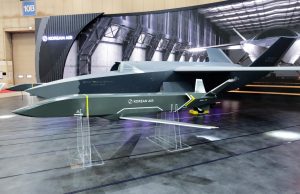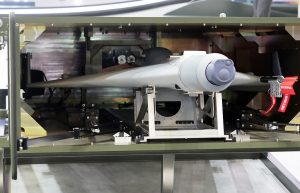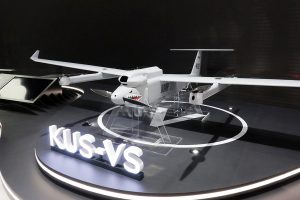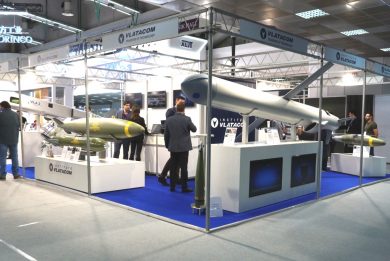ADEX 2025 – Korean Air widens its unmanned air systems portfolio unveiling LOWUS, KUS-FX and Loitering Munition
At the Seoul exhibition Korean Air stand occupied a wide surface, several unmanned systems, and not only, being showcased. Among firsts we could fine the LOWUS (Low Observable Wingman UAV System), the KUS-FX small unmanned collaborative aircraft, and the small and medium level Loitering Munitions
Korean Air is the largest airline of the Republic of Korea, however it does not limit its activities to air transport, but leveraging its experience in aviation maintenance it has broadened its scope to aircraft manufacturing, and is becoming a major military aviation provider, mostly but not only in the unmanned domain. At ADEX 2023 it exhibited several developmental UAVs and UCAVs, and at the 2025 edition of the Seoul event some new airframes were added, the LOWUS, which is being proposed as the loyal wingman for the KF-21 future Korean fighter, the KUS-FX, a new member of the KUS family, and two Loitering Munitions.
In 2022 Korean Air started developing the LOWUS jointly with the Korean Agency for Defense Development (ADD). It has now finished the integration of all subsystems, the first flight being currently scheduled for May 2026. Two prototypes are being produced, one being considered as a backup. To operate together with manned aircraft the LOWUS will have manned-unmanned teaming (MUM-T) capabilities.
Low visibility was a high design priority; the LOWUS has a nearly triangular section fuselage, high sweptback wings and a V-shaped rear empennage. It is powered by a 5,500 lbf thrust turbofan, which wide air intake is on top of the fuselage. No information was provided on stealth coating, but this will certainly be part of the signature reduction process. 10.4 metres long, the LOWUS has a 9.4 metres wingspan and is 2.3 metres high. It is fitted with a front tricycle landing gear. According to Korean Air sources, maximum speed will be Mach 0.85 while cruise speed will be 0.60 Mach. Non information was provided on range, which seems to be the most classified data, endurance being over 3 hours. Maximum take-off mass is 5,700 kg, while payload is 500-600 kg. Its key missions will be intelligence surveillance and reconnaissance, electronic warfare, deception and jamming, as well as strike operations, the payload allowing for two air-to-ground missiles to be carried. The LOWUS will be able to conduct autonomous missions and will be fitted with advanced flight controls. The data provided were those for the Block 1 aircraft. EDR On-Line understood a Block 2 model is already on the Korean Air R&D computers; it will be a bigger aircraft, which will be powered by the same engine, however this one fitted with an afterburner, and will be able to operate from an aircraft carrier.
The KUS-FX is a cruise missile that can be launched from a square section canister, its width and height when wings and tail are stowed being 0.5×0.5 metres. The airframe is 4 metres long, with low swept wings which span is 2.8 metres; these are folded backwards while tail wings are folded forward along the fuselage. Pictorials show a container from which a nine-cell launcher is raised launching the KUS-FX at angle. The Korean Air missile has a mass at launch of 226 kg and is powered by a turbojet providing a 1,300 N thrust, allowing the KUS-FX to reach a maximum speed of Mach 0.85 and a cruise speed of Mach 0.6-0.7. As usual range remains classified, endurance being 1.5 hours while the ceiling is 20,000 ft. The KUS-FX is designed for operating in high risk areas at the beginning of a campaign, carrying out different missions; its modular architecture allows to shift from one payload to another, which may include optronic sensors for ISR and target acquisition missions, radar cross section amplifiers for deception missions, electronic warfare packages and others; lethal payloads are not mentioned by the company, but modularity should allow to transform the KUS-FX in an offensive asset. The missile is in full development, Korean Air having teamed with Anduril, the Californian company providing the AI-based pilot. The KUS-FX first flight is expected to take place in 2027-27.
What are definitely offensive assets are the two delta-wing Loitering Munitions, also developed in cooperation with the ADD, both deployable from a single or multiple cell launcher installed for example on a vehicle. They are powered by a rear mounted internal combustion engine driving a two-blade pushing propeller. The fuselage is cylindrical wings are fitted with winglets at extremities, the optronic sensor package being installed at the front; no vertical tail surfaces are fitted, as these are contained in the wing thickness and rotate up and down once the airframe leaves the launch canister. The Small LM is 1.5 metres long, it has a 1.2 metres wingspan, has a take-off mass of 25 kg and carries a 2-3 kg warhead of unspecified type. The munition exploits an image-based terminal guidance to hit the target, static or moving, once this has been confirmed by the operator who can observe the scene thanks to the 50 km range data link, the 2.5 hours endurance allowing the munition to loiter over the scene and eventually be shifted on a different target. The Small LM can operate in swarms, in order to saturate enemy defences.
The Medium Loitering Munition is 2.4 metres long and has a 2.9 metres wingspan, the airframe architecture being very much similar to that of the Small LM, of course with a more powerful engine, no more details being available on propulsion. The take-off mass is considerably higher, 150 kg, as well as the warhead, 25 kg, endurance being over 10 hours. The range is very much based on endurance, the data link being based on low earth orbit satellites. An AI-based automatic target recognition system.
The Small LM is fully developed but is not yet in production, while the Medium LM is still under development.
Developed jointly with the Agency for Defense Development (ADD), the new medium strike UAV follows the successful development and production of the company’s small strike UAV. Korean Air aims to complete the development of this medium-class system by 2026.
Korean Air also exhibited the KUS-VS; this is a version of the Aerovironment Jump 20 that is being developed by the Korean company based on a cooperation agreement with Aerovironment and aimed to adapt the US-made VTOL ISR drone. The scaled-up version will have a higher take-off mass, this being increased from 97 to 150 kg, EDR On-Line learned. The new version should be ready in 2-3 years time.
Photos by P. Valpolini









